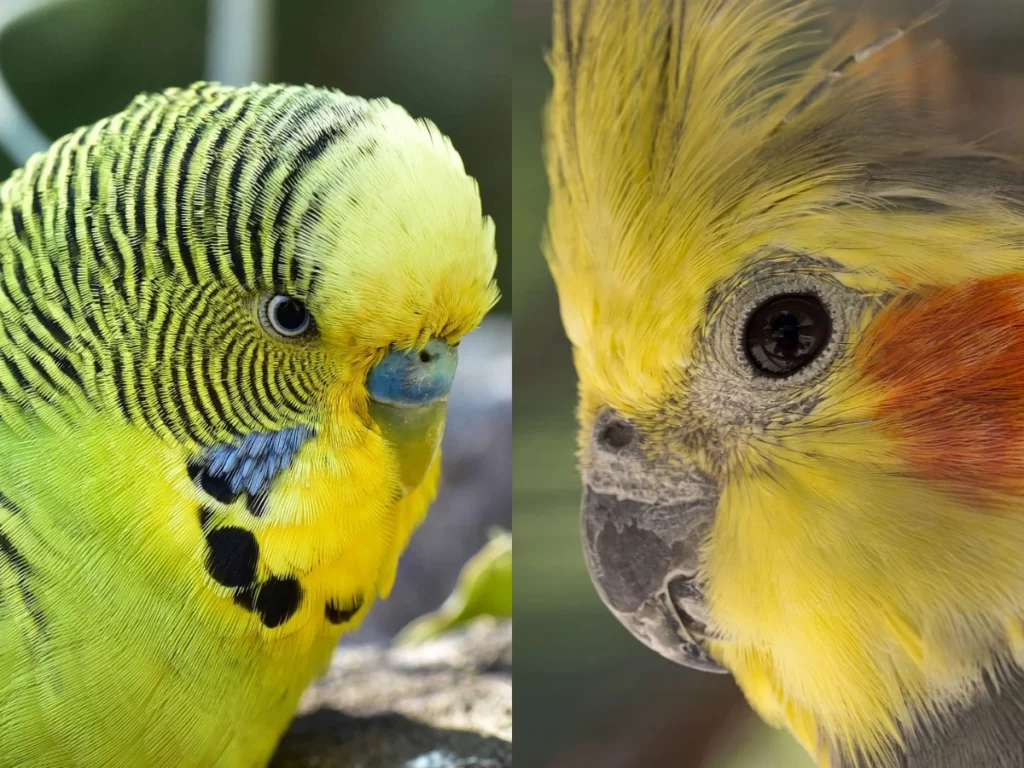Budgies and cockatiels both hail from Australia and have become cherished companions due to their captivating personalities and adaptability.
Cockatiels, often described as more docile and affectionate, are inclined to enjoy petting and showcase their attachment through preening.
They’re larger, with lifespans reaching beyond 20 years. Budgies, though smaller, are playful, energetic, and often prefer perching to petting.
Both can be trained, but interaction styles differ. Regular care for both involves routine cage cleaning and fresh water.
Your preference for interaction, size, and lifespan should guide your choice.
For those in pursuit of a feathery companion, budgies and cockatiels are often top choices.
Having been a devoted budgie owner, I’ve come to appreciate the nuances of these birds.
This content, derived from personal experience and thorough research, aims to offer a comprehensive comparison between the two, guiding potential bird owners in their decision-making process.
Whether you’re looking for companionship, ease of care, or intelligence in a pet, this guide promises clarity on what each bird brings to the table.

Basic Differences Between Budgies and Cockatiels
Origin and natural habitat: Both budgies and cockatiels originate from the arid, inland regions of Australia.
While their habitats in the wild may be similar, these birds have over time adapted to various conditions, making them versatile and resilient pets for homes across the world.
Physical appearance: size, color, and features:
- Cockatiels measure between 12-14 inches long (30.5-35.6 cm) and sport a distinct crest on their heads. They typically come in a variety of color mutations developed in captivity, but their natural coloring is a mix of grey, white, and yellow.
- Budgies, on the other hand, have a size range of 5-11 inches (12.7-28 cm) due to selective breeding. Like cockatiels, budgies also exhibit a multitude of color mutations. They’re recognized for their vibrant hues and slim, long-tailed physique.
Family classification:
- Budgies are classified as parakeets, which are a group of long-tailed, slim-bodied birds found globally. Their playful and chatty nature is characteristic of this bird classification.
- Cockatiels belong to the cockatoo family. This makes them close relatives of some larger and more exotic bird species. Their general low energy, love for preening, and more docile nature sets them apart from the energetic budgies.
Care Requirements: Budgies vs Cockatiels
When deciding between budgies and cockatiels, it’s essential to understand their specific care needs to ensure they live healthy, happy lives.
Budgies
Budgies are vibrant and active birds that require proper care to thrive in a home environment.
Diet and nutrition:
- Budgies primarily eat seeds, but a diet solely based on seeds isn’t ideal. They benefit from a balanced diet that includes pellets, fresh fruits, and vegetables.
- Regularly provide them with fresh water and ensure they have access to calcium sources, like cuttlebones.
- Remember to avoid chocolate, avocado, and high caffeine foods as they are harmful.
Housing and cage setup:
- A budgie’s cage should be spacious enough to allow them to flap their wings and hop around.
- The cage should be at least 18 x 18 x 24 inches (45 x 45 x 60 cm).
- They enjoy toys, so adding a variety like bells, mirrors, and swings can keep them entertained. However, loud toys might add to the noise in your living space.
- Change the newspaper or lining at the cage bottom regularly, perhaps weekly.
Health care and potential issues:
- Budgies need regular nail and beak trims.
- They can suffer from conditions like mites, respiratory issues, and tumors. Regular vet check-ups are essential to detect any potential problems early.
Cockatiels
Cockatiels are known for their sweet nature and distinct crest. Their care requirements differ slightly from budgies.
Diet and nutrition:
- While cockatiels also eat seeds, they too need a balanced diet of pellets, fresh fruits, and vegetables.
- Calcium is vital, so providing a cuttlebone is essential.
- As with budgies, chocolate, avocado, and high caffeine foods are no-nos.
Housing and cage setup:
- Cockatiels are larger than budgies, so their cages need to be more expansive. A recommended size is 24 x 24 x 24 inches (60 x 60 x 60 cm) at a minimum.
- They love toys, but their play tends to be more interactive and explorative.
- Ensure the cage is cleaned regularly, with more extensive cleanings every other week due to their larger size and waste production.
Health care and potential issues:
- Cockatiels, like budgies, require nail and beak trims.
- They can have health concerns like feather plucking, respiratory issues, and beak deformities. Regular vet visits help monitor and address these potential issues.
Companionship: Budgies vs Cockatiels
Taking care of a pet bird is not just about providing them with food, water, and shelter.
It’s also about understanding their social and emotional needs. Let’s see how budgies and cockatiels compare when it comes to companionship.
Budgies
Behavior and interaction with humans:
Budgies are energetic, playful, and quite chatty birds.
While they’re friendly, they generally prefer not to be touched but will happily perch on fingers.
They can be hand-tamed, and male budgies might even learn to talk, which can be an entertaining aspect of their companionship.
Suitability for families, children, and other pets:
Budgies are adaptable and can fit into most home situations.
Their nature makes them suitable for both children and adults. However, supervision is essential when they interact with children to ensure gentle handling.
When it comes to other pets, budgies, being small, can be vulnerable.
It’s vital to ensure that larger pets, especially cats and dogs, don’t pose a threat.
Social needs and group dynamics:
In the wild, budgies live in flocks and are social creatures.
They thrive on interaction and can get lonely if left alone for extended periods.
If you’re considering a budgie as a pet and have a busy lifestyle, it might be a good idea to get a pair so they can keep each other company.
Cockatiels
Behavior and interaction with humans:
Cockatiels have a low energy demeanor and often spend their time preening.
They’re known to be very loving, leaving no doubt that they enjoy human company.
They can be more tolerant of petting than budgies and can also form strong bonds with their human caregivers.
Suitability for families, children, and other pets:
Just like budgies, cockatiels are suitable for both children and adults.
Their docile nature, especially in females, can make them a hit in family settings.
However, as with all pets, it’s essential to ensure children handle them gently.
Regarding other pets, the same rule applies as with budgies: ensure larger animals don’t pose a threat.
Social needs and group dynamics:
Cockatiels, in their natural habitat, live in groups.
While they can be kept alone if they receive enough attention, having a companion cockatiel can be beneficial for their mental well-being.
A pair of cockatiels can provide companionship to each other, especially during times when their human caregivers are away.
In summary, both budgies and cockatiels make wonderful companion pets.
Intelligence and Training: Budgies vs Cockatiels
When considering a pet bird, their intelligence and trainability are important factors.
Let’s dive deeper into the cognitive abilities of both budgies and cockatiels and how these attributes can influence training.
Budgies
Cognitive abilities and problem-solving skills:
Budgies are remarkably smart birds. In the wild, their environment in arid, inland Australia has shaped them to be quick thinkers and problem solvers.
In homes, many budgie owners are often surprised by the bird’s capacity to figure things out, from navigating their surroundings to manipulating toys.
Trainability: tricks, talking, and commands:
Budgies can be trained quite effectively. Due to their innate curiosity and adaptability, they can learn a variety of tricks.
Furthermore, while not all budgies will talk, the males especially have been known to mimic words and even songs.
With patience and consistent training, these birds can respond to simple commands.
Common challenges in training and solutions:
Like all animals, budgies have their moments of stubbornness or distraction.
Training might be difficult if the bird is not in the mood or too energetic.
To overcome these challenges, it’s beneficial to train during their calmer periods.
Using positive reinforcements like treats can also be effective. Remember, budgies thrive on routine and consistency, so regular short training sessions are key.
Cockatiels
Cognitive abilities and problem-solving skills:
Cockatiels, being part of the cockatoo family, are also intelligent birds.
Their behavior often showcases their problem-solving abilities, especially when it comes to interacting with toys or finding cozy spots in their environment.
Their calm and observant nature allows them to assess situations before acting, reflecting their cognitive depth.
Trainability: tricks, talking, and commands:
Cockatiels are trainable, but their style might be different from budgies.
They are more likely to respond to physical cues such as step-up commands or simple tricks.
Male cockatiels might learn to whistle tunes or mimic common household noises.
However, their talking ability isn’t as pronounced as some male budgies.
Common challenges in training and solutions:
Cockatiels are generally low-energy birds, but they can have moments of shyness or reluctance.
It’s essential to approach them with patience, especially during the initial stages of training.
Using gentle encouragements and treats can motivate them. And, as with budgies, consistent and routine training is the secret to success.
Which Bird Is Right for You? Budgies vs Cockatiels 📺
Birds can be a wonderful addition to any household, but which one suits you best: a budgie or a cockatiel?
Let’s delve into their unique characteristics to help you decide.
Comparing Size and Space Requirements
- Budgies are smaller in size, typically ranging from 5-11 inches long (12.7-27.9 cm). This means they might require a slightly smaller living environment.
- Cockatiels, on the other hand, are larger. They’re around 12-14 inches long (30.5-35.6 cm). This means they’d need a bit more space.
Remember! Regardless of the bird, they all appreciate spacious cages and room to fly.
Interaction Styles: Hand Taming, Petting, and Handling
- Budgies: These birds are very trainable and can become hand tame. They might not be a big fan of petting but love to perch on fingers. They can be described as energetic, playful, and a bit chatty.
- Cockatiels: They are generally more tolerant of petting and might even enjoy it. They’re known to be low-energy, so they spend a good chunk of their time preening themselves.
It’s crucial to note the importance of individual personalities. While these are general traits, every bird is unique.
Lifespan and Long-Term Commitments
- Budgies: These little birds can live for about 10-15 years if well-taken care of. That’s a considerable amount of time and requires a dedicated commitment.
- Cockatiels: They can live even longer, with a lifespan of 15-20+ years. This longer lifespan means a more extended commitment and long-term care.
Frequently Asked Questions
Is It Easier to Train a Budgie or a Cockatiel for Tricks?
Both budgies and cockatiels can be easily hand tamed and taught other behaviors.
Budgies are known to be trainable and can become quite hand tame, meaning they can learn tricks.
However, it can be said that cockatiels, due to their docile nature, might be easier for beginners to train.
How Does the Social Bond Differ Between Budgies and Cockatiels?
Cockatiels are very loving and leave you with no doubt that they enjoy being around you.
They’re generally low-energy birds and can be more tolerant of petting. On the other hand, budgies give the impression of being cool with their owners but might not show as much affection as cockatiels.
Both species are social and crave interaction.
While both birds can adapt to home situations, due to their differences in size and behavior, it’s not recommended to house them in the same cage.
They have different activity levels and might not get along well in a confined space.
Which Bird Requires More Mental Stimulation Activities?
Budgies are energetic, playful, and quite chatty. This means they might require more toys and stimulation activities to keep them engaged.
Cockatiels, being low-energy, might not need as much, but they still enjoy toys, especially those they can preen.
How Do Their Diets Differ in Terms of Nutritional Needs?
Both birds have their unique dietary needs, but a balanced diet of seeds, pellets, fruits, and vegetables is essential for both.
Ensure fresh water is always available. For specific dietary requirements, always consult an avian veterinarian.
Are There Specific Health Concerns to Watch Out for in Either Bird?
Both birds are relatively healthy if cared for properly. Regular cage cleaning and fresh food and water are essential.
Watch out for signs of illness like changes in behavior, eating habits, or appearance.
Which Bird Is More Adaptable to Different Living Conditions?
Both budgies and cockatiels are adaptable to various conditions, even less than ideal situations.
However, they’re especially suitable for apartments due to their quieter nature. Always ensure they have enough space to move around in their cages.
How Does Age Affect the Trainability of Budgies Vs. Cockatiels?
Younger birds of both species might be easier to train as they are more adaptable and curious.
However, with patience, even older birds can be hand tamed and taught new behaviors.
Which Bird Is More Suitable for First-time Bird Owners?
While both species are suitable for both children and adults, cockatiels might be a bit easier for first-time bird owners because of their docile nature and the loving bond they form with their caregivers.
However, budgies, being smaller, might be less intimidating for some.



